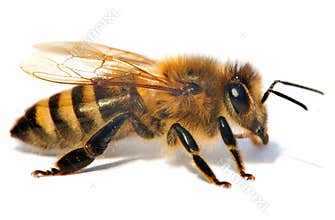Apis Mellifera Honey Bee Feeding On Bidens Genus Plant. This Is An Apis Mellifera Honey Bee Species, Apidae Family. The Most Common Of The 7€“12 Species Of Honey Bees Worldwide. Common Name: Western Honey Bee Or European Honey Bee. The Western Honey Bee Can Be Found On Every Continent Except Antarctica. Apis Mellifera Species Was Domesticated For Honey Production And Crop Pollination Since 2600Bc. The Only Other Domesticated Bee Is The Eastern Honey Bee (Apis Cerana), Which Occurs In South, Southeast, And East Asia. In The 17Th Century, European Colonists Brought Two Subspecies To America: A. M. Mellifera (The German Honey Bee) And A. M. Ligustica (The Italian Honey Bee). The Western Honey Bee Is A Very Important Pollinator Of Crops. Bees Produce Honey By Collecting Nectar, A Clear Liquid Consisting Of Nearly 80 Percent Water And Complex Sugars. Honey Is A Biological Mixture Of Inverted Sugars, Primarily Glucose And Fructose. Western Honey Bees Are Threatened By Pests And Diseases, Especially The Varroa Mite And Colony Collapse Disorder. Observed Near Maya Biosphere Reserve (Mbr), Petã©N Department, Northern Guatemala.
ID 861307948815 © Ricardnature | Megapixl.com
Sharing is not just caring, it's also about giving credit - add this image to your page and give credit to the talented photographer who captured it.:
KEYWORDS
flower plant green nature wildflower insect petal invertebrate apis mellifera honey bee species apidae family bees worldwide western european continent antarctica domesticated crop pollination 2600bc eastern cerana south southeast east asia 17th century colonists brought subspecies america: german ligustica italian pollinator crops collecting nectar clear liquid water complex sugars biological mixture inverted glucose fructose threatened pests diseases colony collapse disorder maya biosphere reserve mbr petén department northern guatemala feeding bidens genus











































